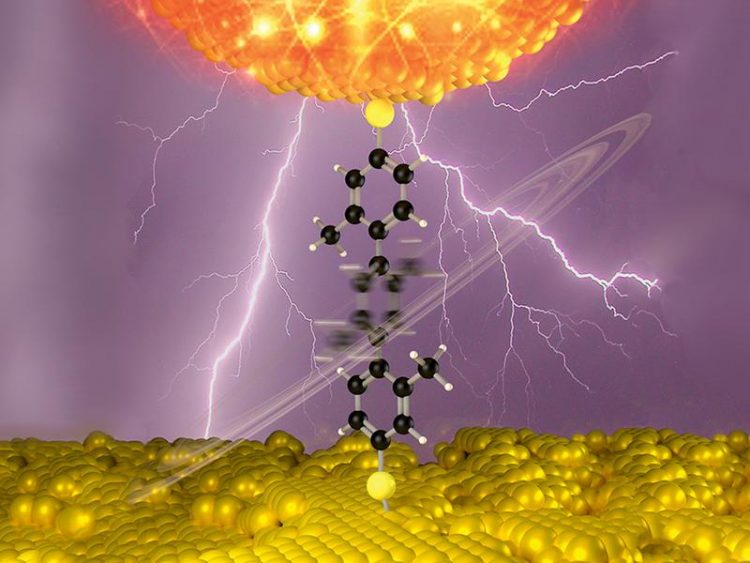Molecular switch will facilitate the development of pioneering electro-optical devices

Electrically switchable organic molecule. Image: Yuxiang Gong / TUM / Journal of the American Chemical Society
The development of new electronic technologies drives the incessant reduction of functional component sizes. In the context of an international collaborative effort, a team of physicists at the Technical University of Munich has succeeded to use single molecules as switching elements for light signals.
“Switching with just a single molecule brings future electronics one step closer to the ultimate limit of miniaturization,” says nanoscientist Joachim Reichert from the Physics Department of the Technical University of Munich.
Different structure – different optical properties
The team initially developed a method that allowed them to create precise electrical contacts with molecules in strong optical fields and to address them using an applied voltage. At a potential difference of around one volt, the molecule changes its structure: It becomes flat, conductive and scatters light.
This optical behavior, which strongly depends on the structure of the molecule, is quite exciting for the researchers because the scattering activity – Raman scattering, in this case – can be both observed and, at the same time, switched on and off via an applied voltage.
Challenging technology
The researchers used molecules synthesized by a team based in Basel and Karlsruhe. The molecules change their structure in a specific way when they get charged. They are arranged on a metal surface and contacted using the corner of a glass fragment with a very thin metal coating as a tip.
This serves as an electrical contact, light source and light collector, all in one. The researchers used the fragment to direct laser light to the molecule and measure tiny spectroscopic signals that vary with the applied voltage.
Establishing reliable electric contacts between individual molecules is extremely challenging from a technical point of view. The scientists have now successfully combined this procedure with single-molecule spectroscopy, allowing them to observe even the smallest structural changes in molecules with great precision.
Competition for Silicon
One goal of molecular electronics is to develop novel devices that can replace traditional silicon-based components using integrated and directly addressable molecules.
Thanks to its tiny dimensions, this nanosystem is suitable for applications in optoelectronics, in which light needs to be switched by an electrical potential.
Publication:
Hai Bi, Carlos-Andres Palma, Yuxiang Gong, Peter Hasch, Mark Elbing, Marcel Mayor, Joachim Reichert und Johannes V. Barth,
Voltage-Driven Conformational Switching with Distinct Raman Signature in a Single-Molecule Junction: J. Am. Chem. Soc. 140, 14, 4835-4840
Link: http://dx.doi.org/10.1021/jacs.7b12818
Further information
The research project was funded by the German Research Foundation (DFG) via the Cluster of Excellence Munich-Centre for Advanced Photonics (MAP) and the SPP 1243, as well as the European Union (ERC Advanced Grant MolArt and FET Measure 2D-ink) and the China Scholarship Council (CSC).
Contact:
Dr. Joachim Reichert / Prof. Dr. Johannes Barth
Technical University of Munich
Surface and Interface Physics (E20)
Tel.: +49 89 289 12608 – E-Mail: e20office@ph.tum.de
http://www.e20.ph.tum.de/en/
https://www.tum.de/nc/en/about-tum/news/press-releases/detail/article/34665/ Link to the press release
Media Contact
All latest news from the category: Power and Electrical Engineering
This topic covers issues related to energy generation, conversion, transportation and consumption and how the industry is addressing the challenge of energy efficiency in general.
innovations-report provides in-depth and informative reports and articles on subjects ranging from wind energy, fuel cell technology, solar energy, geothermal energy, petroleum, gas, nuclear engineering, alternative energy and energy efficiency to fusion, hydrogen and superconductor technologies.
Newest articles

A new way of entangling light and sound
For a wide variety of emerging quantum technologies, such as secure quantum communications and quantum computing, quantum entanglement is a prerequisite. Scientists at the Max-Planck-Institute for the Science of Light…

Telescope for NASA’s Roman Mission complete, delivered to Goddard
NASA’s Nancy Grace Roman Space Telescope is one giant step closer to unlocking the mysteries of the universe. The mission has now received its final major delivery: the Optical Telescope…

Sensitive ceramics for soft robotics
Most people think of coffee cups, bathroom tiles or flower pots when they hear the word “ceramic”. Not so Frank Clemens. For the research group leader in Empa’s Laboratory for…



